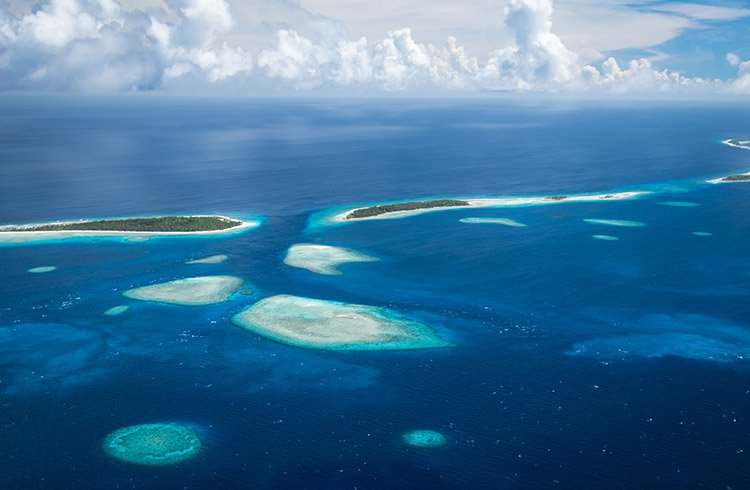Safety in the Marshall Islands: Know Before You Go
The Marshall Islands are very safe to travel to, but here are our top tips on staying healthy and avoiding insect bites.
 Photo © Getty Images/Brandi Mueller
Photo © Getty Images/Brandi Mueller
The Marshall Islands receive a very low number of visitors each year, perhaps because they are hard to reach. The Marshall Islands are made up of low-lying atolls – which are coral reefs that circle a lagoon. If you look on a map, these volcanic islands are located halfway between Hawaii and the Philippines – basically, in the middle of nowhere.
Some of these islands are no-go zones as the enormous area was once used for nuclear testing. So if you're looking for a Pacific island paradise without crowds of tourists, the Marshall Islands might be the ultimate adventure for you.
In 1986, the Marshall Islands gained independence from the US, but continue to be home to the US Army Post Kwajalein (USAKA), so a number of islands are still off-limits due to US military presence or nuclear fall-out. But the remaining atolls and islands (there are more than 1,000 of them) remain a tropical wonderland waiting for exploration.
Crime in the Marshall Islands
For the most part, traveling around the Marshall Islands is very safe. There is a very low crime rate, and the worst thing that could happen to you (like anywhere else in the world) is petty theft or the occasional act of vandalism.
Use your common sense: don't flash your cash around and make yourself an obvious target for thieves. Keep your valuables hidden or locked in a safe at your accommodation, and always lock the door to your room. Be mindful of your safety and security, particularly if you're out late at night.
Sun safety
There aren't a lot of risks to your health in the Marshall Islands, except sunburn or dehydration.
When you get up each morning, apply a broad-spectrum, waterproof sunscreen, and wear a hat and sunglasses. Always aim to reapply sunscreen every few hours, particularly if you have been swimming.
Rainy season in the Marshall Islands
The Marshall Islands are located in the tropics and experience a significant wet season which runs from April to December.
The Marshall Islands are low-lying coral atolls, and islands and are susceptible to tropical cyclones (also called typhoons and hurricanes). If they occur, it'll be during the wet season and they will be closely monitored.
However, they are very unpredictable. Tropical cyclones can change in intensity, veer off course, intensify or weaken quite suddenly and without warning. You should always follow local advice and heed the following:
- Monitor local tv, radio and online news
- Keep in touch with your tour operator or a local contact
- Register with your Embassy, Consulate or High Commission before traveling so they know where you are
- Keep in mind that airports and hotels may shut down if a large hurricane approaches
- Ask your accommodation staff who should have evacuation plans or safety measures in place for severe weather.
Insects and mosquito-borne diseases
Be aware of mosquito-borne diseases such as Dengue Fever or Zika virus, and take appropriate precautions to avoid being bitten. Use insect repellent, wear long sleeves at dawn and dusk when mosquitoes are most active, and try to sleep in a room with insect screens on the windows.
Recommended vaccinations
You should also consider the following vaccinations before traveling:
- Hepatitis A and B
- Typhoid
- Tetanus-diphtheria shots – which are recommended every 10 years
- Tuberculosis (also known as TB)
Be aware when snorkeling or diving around the reefs that there have been reports of unexploded mines from WWII. If you go with a guided tour group, they should be aware of the locations to be more careful.
The only other risk is feral dogs on the islands, of which there are many in and around Majuro Island.
Navigating the Marshall Islands
Due to US military presence and nuclear fall out from testing in the '40s and '50s, several islands are completely off-limits. However, to get around to the rest of the islands, your best bet is either plane or boat.
The fastest way between islands is by plane as the area is vast – a 40 minute trip between islands by plane will take around 24 hours by boat. Keep this in mind when planning your island hopping, and make sure you have scheduled enough time to fit it all in.
On Majuro Island getting around is relatively easy and cheap. Taxis are your best bet, since fares are very reasonable, but there's also a bus that goes to Laura, on the other end of the island, every hour from the Robert Reimers Hotel.
Road conditions on the island are pretty basic. They're paved, but there are no traffic lights and few traffic signals. Dogs, chickens, people, pigs and children tent to roam the streets so be alert for them.
So, what are you waiting for?
On paper, the Marshall Islands do seem like a tropical paradise – few visitors, basic facilities and vast tracks of ocean and coral reefs. What's not to love?
Simple and flexible travel insurance
You can buy at home or while traveling, and claim online from anywhere in the world. With 150+ adventure activities covered and 24/7 emergency assistance.
Get a quote
No Comments